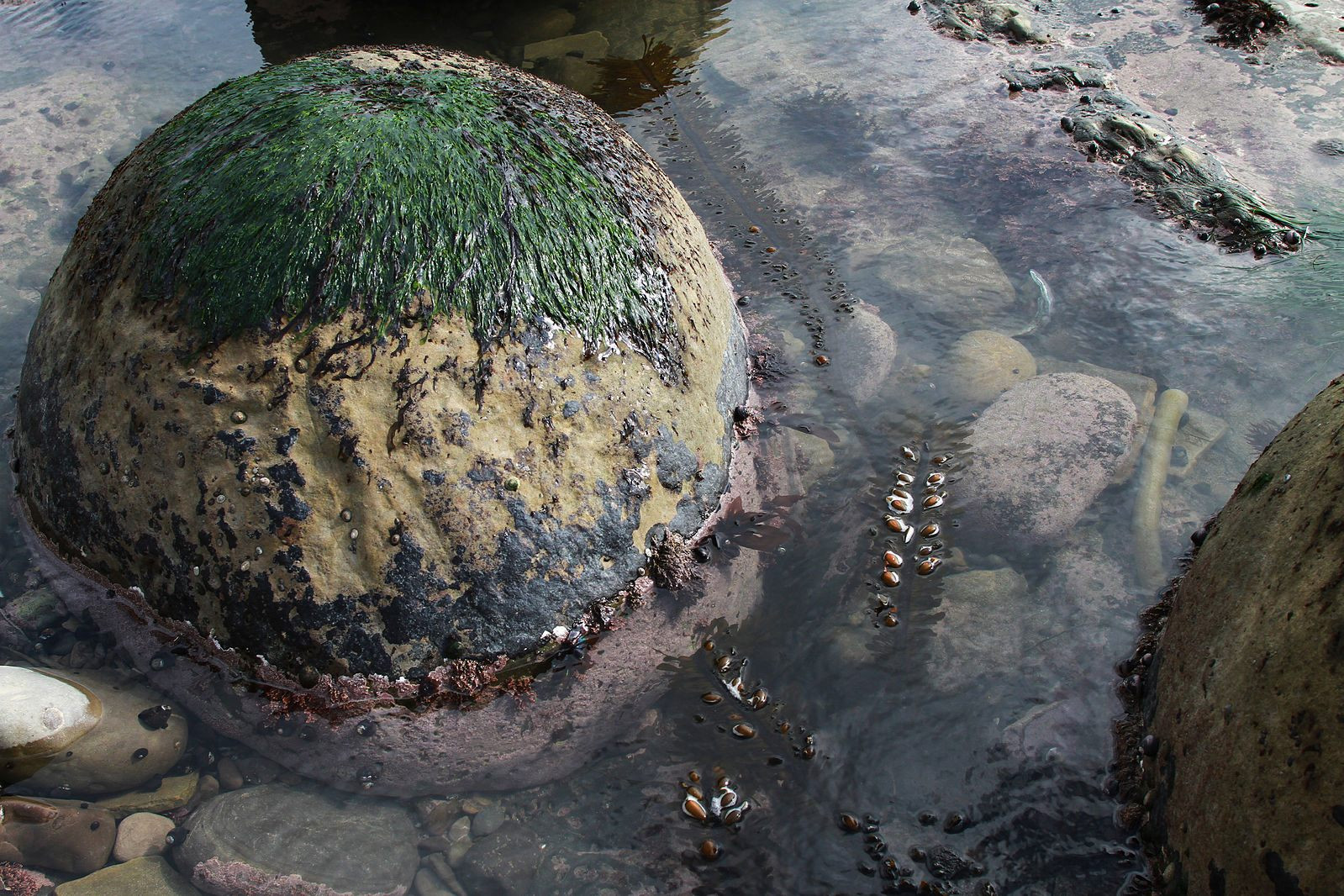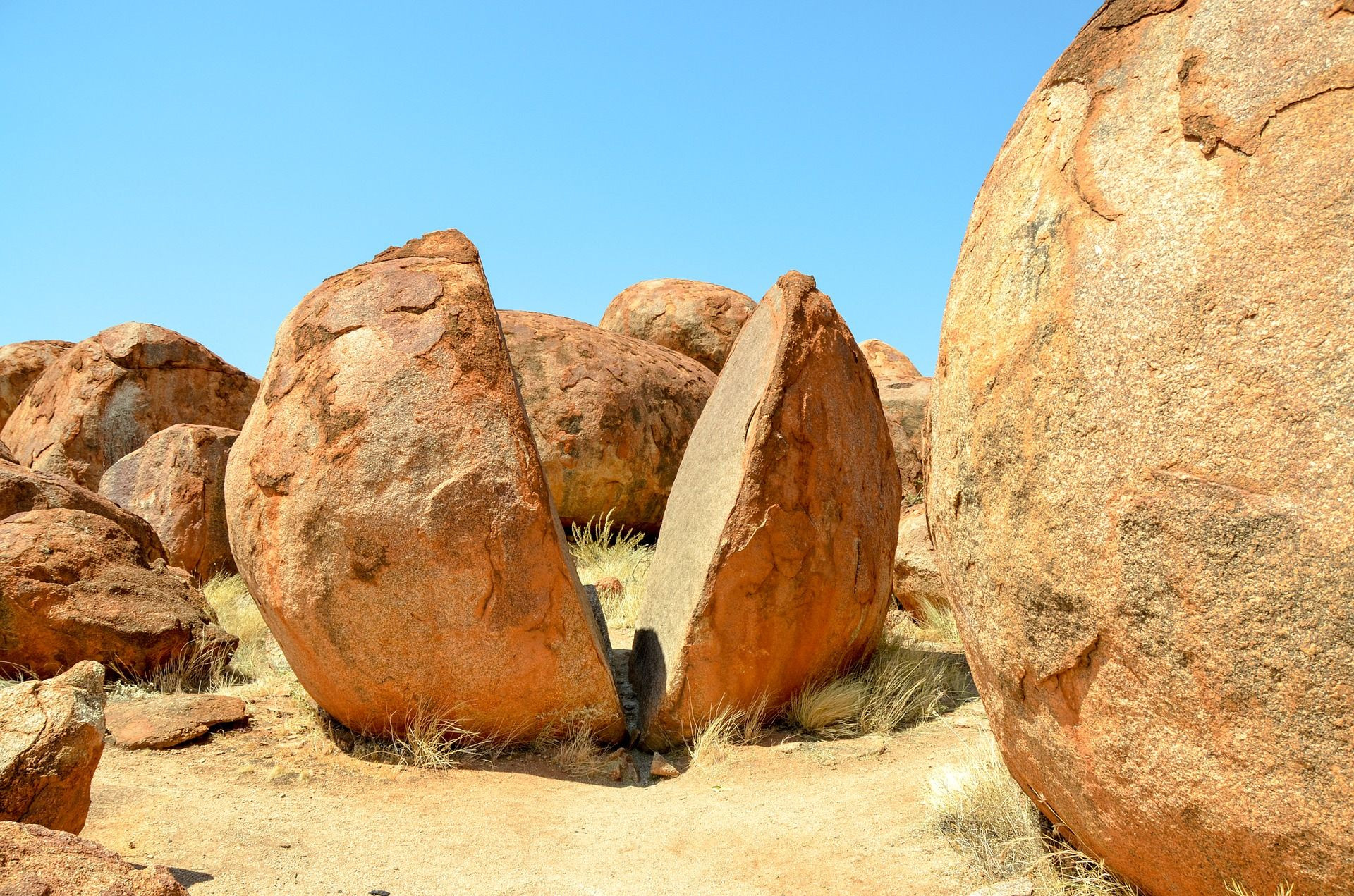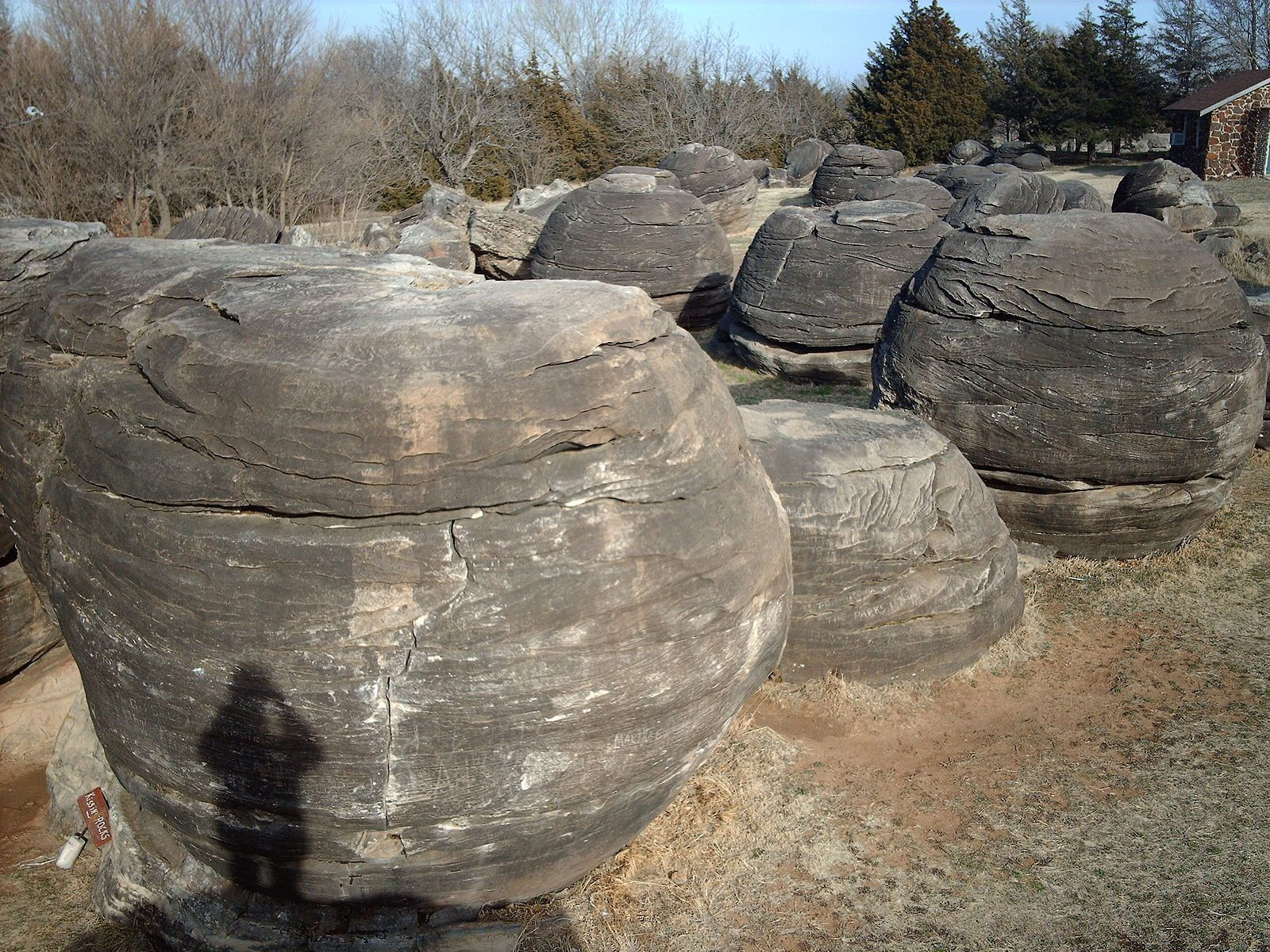Round rocks, those captivating geological curiosities, are formed through a fascinating process called concretion, as seen on rockscapes.net. This process, often spanning millions of years, involves the gradual accumulation and cementation of sediment around a central nucleus, resulting in these striking spherical formations, perfect for any landscape. Let’s delve into the captivating world of round rock formation, exploring their diverse types, applications in landscaping, and how you can incorporate them into your own outdoor spaces using rock arrangements.
1. What is Concretion and How Does It Form Round Rocks?
Concretion is the key to how round rocks are formed. It’s a geological process where minerals precipitate out of solution and cement sediment particles together around a nucleus, forming a rounded mass.
Concretion begins with a nucleus, such as a fossil, shell fragment, or even a small pebble. Water rich in dissolved minerals, like calcite, iron oxide, or silica, permeates through the surrounding sediment. As the water flows, these minerals precipitate out of the solution and deposit around the nucleus. Over time, layer upon layer of mineral deposits accumulate, gradually cementing the surrounding sediment particles together. This process creates a hard, compact mass that is often spherical or oval in shape. The shape is influenced by several factors, including the composition of the sediment, the type of cementing mineral, and the flow of groundwater. Round rocks, in particular, benefit from consistent mineral deposition in all directions, leading to their distinctive spherical form.
2. What Geological Conditions Favor the Formation of Round Rocks?
Specific geological conditions foster the creation of round rocks. These conditions primarily involve the presence of a nucleus, mineral-rich water, and permeable sediment.
- Abundant Nuclei: The presence of abundant nuclei, such as fossils or shell fragments, is essential to start the concretion process.
- Mineral-Rich Groundwater: Groundwater saturated with dissolved minerals like calcite, silica, or iron oxide is crucial. These minerals act as the cementing agents that bind the sediment particles together.
- Permeable Sediment: The sediment must be porous and permeable, allowing the mineral-rich water to flow freely through it. This ensures the even distribution of minerals around the nucleus.
- Stable Environment: A relatively stable geological environment is necessary over long periods. This allows the concretion process to proceed uninterrupted by major geological events.
- Specific Chemical Conditions: Certain chemical conditions, such as pH levels and redox potential, can influence the precipitation of minerals and the rate of concretion formation. According to research from Arizona State University’s School of Earth and Space Exploration, in July 2023, specific chemical conditions in the groundwater are vital for mineral precipitation.
3. What Are the Different Types of Round Rocks Formed by Concretion?
Round rocks formed by concretion come in various types, each distinguished by its composition, size, and geological setting.
- Calcareous Concretions: These are formed with calcite as the primary cementing mineral. They are often found in sedimentary rocks like limestone and shale.
- Siliceous Concretions: Silica acts as the cementing agent in these concretions. They are typically harder and more resistant to weathering than calcareous concretions.
- Iron Oxide Concretions: These concretions are rich in iron oxides, such as hematite or goethite, giving them a reddish-brown color.
- Cannonball Concretions: These are large, spherical concretions that can range from a few feet to several meters in diameter. They are often found in sedimentary rocks like sandstone and shale.
- Septarian Concretions: Characterized by internal cracks filled with minerals like calcite or barite, these concretions form when the concretion’s interior shrinks, creating fissures that subsequently fill with minerals.
4. Where Can You Find Examples of Round Rocks Around the World?
Several locations worldwide are renowned for their remarkable displays of round rocks, offering geologists and enthusiasts alike the chance to witness these natural wonders.
- Moeraki Boulders, New Zealand: These large, spherical boulders scattered along the Otago Coast are among the most famous examples of concretions.
- Bowling Ball Beach, California, USA: As its name suggests, this beach is covered in round concretions that resemble bowling balls.
 Round concretions resembling bowling balls at Bowling Ball Beach in California
Round concretions resembling bowling balls at Bowling Ball Beach in California
- Rock City, Kansas, USA: This park features a collection of large, spherical sandstone concretions.
- Devils Marbles, Australia: Also known as Karlu Karlu, these iconic granite boulders hold cultural significance for the Aboriginal people.
 A split concretion at Devils Marbles in Australia revealing its internal structure
A split concretion at Devils Marbles in Australia revealing its internal structure
- Torysh Valley, Kazakhstan: Known as the “Valley of Balls,” this region is scattered with concretions of various sizes.
5. How Are Round Rocks Used in Landscaping and Garden Design?
Round rocks are versatile elements in landscaping and garden design, offering aesthetic appeal and practical functionality.
-
Focal Points: Use large, round rocks as focal points in gardens or landscapes. Their unique shape and texture draw the eye and create visual interest.
-
Edging and Borders: Utilize smaller round rocks to create edging and borders around flower beds, pathways, or water features.
-
Rock Gardens: Incorporate round rocks into rock gardens, combining them with drought-tolerant plants and other geological elements.
-
Water Features: Integrate round rocks into water features like ponds or fountains. They add a natural, soothing element to the design.
-
Pathways and Walkways: Use round rocks to create pathways and walkways through gardens or landscapes.
-
Zen Gardens: Incorporate round rocks into Zen gardens, using them to represent mountains or islands in a minimalist landscape.
6. What Are the Benefits of Incorporating Round Rocks Into Your Landscape?
Incorporating round rocks into your landscape offers numerous benefits, ranging from aesthetic enhancement to environmental advantages.
- Aesthetic Appeal: Round rocks add a natural, organic element to landscapes, enhancing their visual appeal.
- Low Maintenance: Once in place, round rocks require minimal maintenance compared to other landscaping elements.
- Erosion Control: They can help control erosion by stabilizing soil and preventing runoff.
- Weed Suppression: Round rocks can suppress weed growth by blocking sunlight and preventing weed seeds from germinating.
- Water Conservation: They can help conserve water by reducing evaporation from the soil surface.
- Durability: Round rocks are durable and weather-resistant, ensuring long-lasting beauty in your landscape.
- Versatility: They can be used in a variety of landscaping styles, from traditional to modern.
7. How Do You Choose the Right Size and Type of Round Rock for Your Project?
Selecting the right size and type of round rock for your landscaping project is essential to achieve the desired aesthetic and functionality.
- Consider the Scale: Choose rock sizes that are proportional to the scale of your landscape. Larger rocks are suitable for larger spaces, while smaller rocks are better for smaller areas.
- Match the Style: Select rock types that complement the style of your landscape. For example, smooth, rounded river rocks are ideal for naturalistic designs, while more angular rocks may be better suited for modern or contemporary landscapes.
- Think About Function: Consider the function of the rocks. If you are using them for pathways, choose rocks that are comfortable to walk on. If you are using them for erosion control, select rocks that are large enough to stay in place during heavy rains.
- Color Coordination: Coordinate the color of the rocks with the other elements in your landscape, such as plants, mulch, and structures.
- Local Availability: Opt for locally sourced rocks whenever possible. This can reduce transportation costs and ensure that the rocks are well-suited to your local climate and soil conditions.
8. How Do You Install Round Rocks in Your Landscape?
Installing round rocks in your landscape requires careful planning and execution to ensure stability and aesthetic appeal.
- Prepare the Site: Clear the area of any vegetation, debris, and loose soil. Grade the surface to ensure proper drainage.
- Lay Landscape Fabric: Install a layer of landscape fabric to prevent weed growth and soil erosion.
- Position the Rocks: Place the rocks in your desired arrangement, taking care to space them evenly and create a natural-looking design.
- Secure the Rocks: For larger rocks, you may need to bury them partially in the ground to provide additional stability.
- Fill the Gaps: Fill the gaps between the rocks with smaller stones, gravel, or mulch.
- Water Thoroughly: Water the area thoroughly to help settle the rocks and compact the soil.
9. What Maintenance Tips Should You Follow to Keep Your Round Rock Landscape Looking Its Best?
Maintaining a round rock landscape is relatively easy, but following these tips will help keep it looking its best.
- Remove Debris: Regularly remove any leaves, twigs, or other debris that accumulate on the rocks.
- Control Weeds: Spot-treat any weeds that grow through the landscape fabric with a herbicide.
- Replenish Mulch: Replenish the mulch around the rocks as needed to maintain a consistent layer.
- Clean the Rocks: Occasionally clean the rocks with a brush and water to remove any dirt or stains.
- Adjust the Arrangement: If any rocks shift or settle over time, adjust their arrangement to maintain the desired look.
10. Where Can You Purchase Round Rocks for Your Landscaping Project in the USA?
Finding a reliable source for round rocks is crucial for a successful landscaping project. In the USA, several options are available to purchase round rocks for your landscaping needs.
- Local Stone Yards: Stone yards are a great place to find a variety of round rocks, including river rocks, granite boulders, and other types of decorative stones. They often offer competitive prices and can provide expert advice on selecting the right rocks for your project.
- Landscaping Supply Stores: Landscaping supply stores typically carry a range of round rocks, along with other landscaping materials like mulch, soil, and plants.
 Spherical boulders at Rock City in Kansas, some reaching nearly 30 feet in diameter
Spherical boulders at Rock City in Kansas, some reaching nearly 30 feet in diameter
- Online Retailers: Several online retailers sell round rocks and deliver them directly to your home. This can be a convenient option if you don’t have a local stone yard or landscaping supply store nearby.
- Direct from Quarries: In some cases, you may be able to purchase round rocks directly from quarries. This can be a cost-effective option if you need a large quantity of rocks.
Round rocks are more than just geological formations; they’re nature’s sculptures, adding character and charm to any landscape. Whether you’re aiming for a serene Zen garden or a striking rock garden, incorporating these spherical wonders can transform your outdoor space.
Ready to bring the timeless beauty of round rocks to your landscape? Visit rockscapes.net today for inspiration, expert advice, and a wide selection of high-quality stones to suit your unique vision. Let us help you create an outdoor oasis that reflects your style and appreciation for nature’s artistry. For personalized assistance, contact us at Address: 1151 S Forest Ave, Tempe, AZ 85281, United States or Phone: +1 (480) 965-9011. Your dream landscape awaits.
FAQ Section
Q1: What exactly is a concretion, and how does it relate to the formation of round rocks?
A1: Concretion is a geological process where minerals in water solution cement sediment particles around a nucleus, like a fossil, creating a hard, rounded mass, which results in the formation of round rocks. This natural phenomenon is how these geological curiosities come to be.
Q2: What are the essential geological conditions required for round rock formation through concretion?
A2: The essential geological conditions include a nucleus (like a fossil), mineral-rich groundwater, permeable sediment, a stable environment, and specific chemical conditions that favor mineral precipitation and cementation. These conditions, working together over time, produce the unique spherical shapes of round rocks.
Q3: Can you describe the different types of round rocks that are formed by the concretion process?
A3: Different types of round rocks formed by concretion include calcareous concretions (cemented by calcite), siliceous concretions (cemented by silica), iron oxide concretions (rich in iron oxides), cannonball concretions (large, spherical), and septarian concretions (with internal cracks filled with minerals). Each type showcases unique mineral compositions and geological stories.
Q4: Where in the world can I find notable examples of round rocks formed by concretion?
A4: You can find notable examples of round rocks at Moeraki Boulders in New Zealand, Bowling Ball Beach in California, Rock City in Kansas, Devils Marbles in Australia, and Torysh Valley in Kazakhstan. These sites offer stunning displays of these natural wonders.
Q5: How can round rocks be effectively used in landscaping and garden design to enhance visual appeal?
A5: Round rocks can be used as focal points, edging, in rock gardens, water features, pathways, and Zen gardens. Their versatility and natural beauty make them perfect for enhancing any landscape design.
Q6: What are the main benefits of adding round rocks to my landscape or garden?
A6: The main benefits include aesthetic appeal, low maintenance, erosion control, weed suppression, water conservation, durability, and versatility in design. Round rocks offer both practical and visual advantages for your outdoor spaces.
Q7: How should I go about choosing the most suitable size and type of round rock for my specific landscaping project?
A7: Consider the scale of your landscape, match the style, think about the function of the rocks (pathways, erosion control), coordinate the color with other elements, and prioritize local availability. These factors will ensure you select the best round rocks for your project.
Q8: What are the basic steps involved in installing round rocks correctly in a landscape setting?
A8: The basic steps involve preparing the site, laying landscape fabric, positioning the rocks, securing them (if necessary), filling the gaps with smaller stones or mulch, and watering thoroughly. Proper installation ensures stability and a visually appealing arrangement.
Q9: What maintenance practices should I follow to keep my round rock landscape in top condition?
A9: Regularly remove debris, control weeds, replenish mulch, clean the rocks as needed, and adjust their arrangement if they shift. Simple maintenance keeps your round rock landscape looking its best.
Q10: Where can I reliably purchase round rocks for my landscaping project in the USA?
A10: You can purchase round rocks from local stone yards, landscaping supply stores, online retailers, and sometimes directly from quarries. Choosing a reliable source ensures you get quality stones for your project.